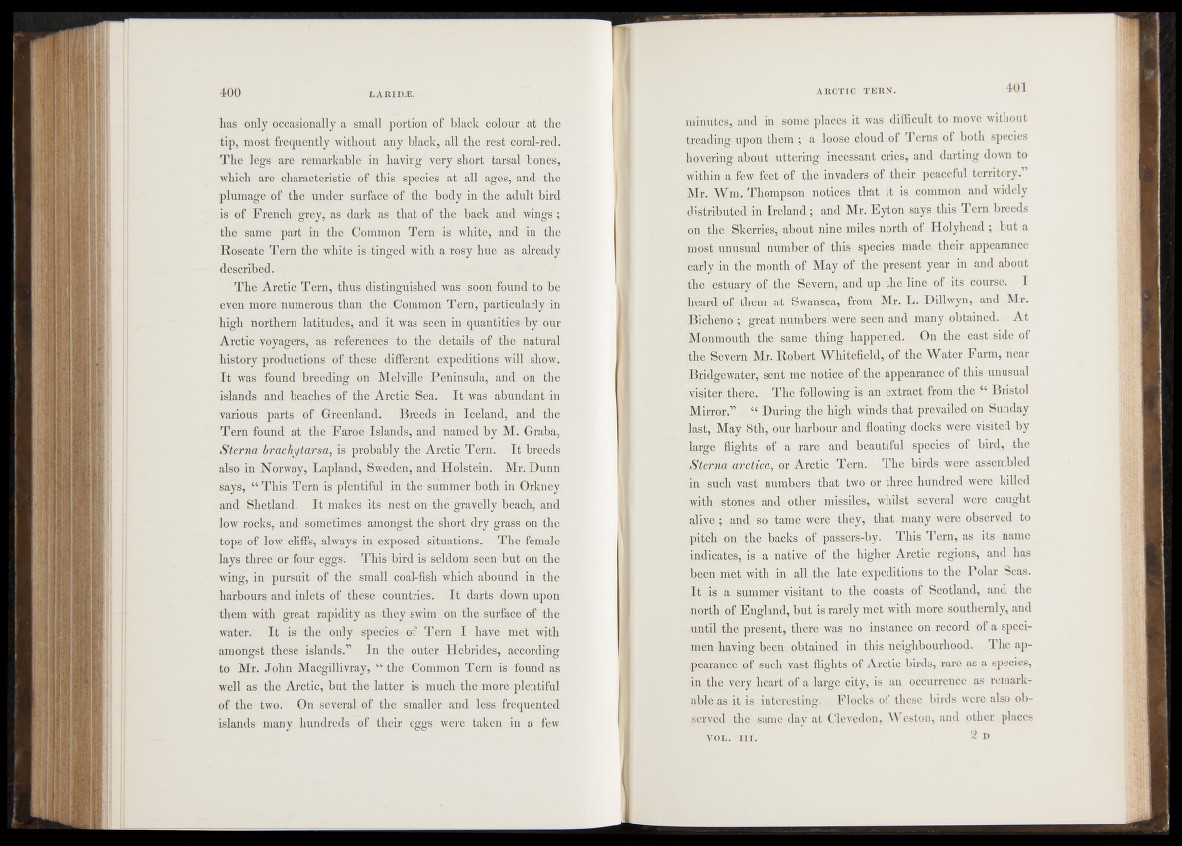
has only occasionally, a small portion of|||laek colour at the
tip, most frequently’without any black, -all the rest coral-red.
The legs are remarkable in having -very short tarsal bones,
which are characteristic of this species at all ages, and the
plumage of the under surface of the body in the- adult|J|iid
is of French grey, ias dark as that of the back and wings;
the same part in the' Common "Tern ?is‘ white, and in the
Roseate Tern the white i&tingf® with a’topsy hue as already
describe^.
The Arctic Tern, thus distinguished was soon found to'-be
even more numerous than the Common Tern, -particularly in
high northern latitudes, and it was §ein?in quantities;Jby our
Arctic voyagers, as-references -to,- the" details* of the. natural
history productions Of'these different expeditions will sho#.
I t was found breeding on Mtlyille Peninsula, and: on the
islands and beaches of the Arctic Sea. I t was abundant in
various parts. of Greenland^: Breeds in Iceland, and the
Tern found at the Faroe Islands, and. named by M. Graba,
Sterna brachytarsa, is probably the Arctic Tern. Tt breads
also in Norway, Lapland, Sweden, and Holstein. • Mr. Dunn
says, “ This Tern is plentiful in 'the sumtner bdih'-in Orkney
_and Shetland. It makes its -nest on the gravelly'-beach,' and
low rocks, and sometimes amongst the short dry grass on the
tops of low cliffs^ always in expos'd situations. -'The female
lays three or four eggs. -This bird is seldom seen but on the
wing, in pursuit of the small coal-fish which abound in the
harbours and inlets of'these countries “I t darfs^down.upoir
them with great rapidity as they swim on the surface of the
water. I t is the only species«-of Tern I have met with
amongst these- islands.” In the outer Hebrides, according
to Mr. John Macgillivray, “ the Common Tern is .'found as
well as the Arcticr but the latter is much the more plentiful
of the two. On several of’ the smaller and less frequented
islands many hundreds of their eggs were taken in a few
minolst* and in some places it was difficult to move without
treading upon tkeîh ; a loose cloud of Tems of both species
hovering about uttering, incessant cries, and darting down to
within «a few feet ;of the invaders of their peaceful territory.”
Mr. Wm. Thompson notices that it is common and widely
distributed in Ireland;, and Mr. Eyton says this Tern breeds
.on the Skerries, about' nine miles north of Holyhead ; but a
nmst unusual number of this species made their appearance
early in the month of May of' the present year in and about
thëy^stuary of the .Severn,’and up the line; of its course. I
heard óf* them at Swansea, from Mr. L. Dillwyn, and Mr.
Biohemo^i^great numbers Were seen and man y ^obtained. At
Monmouth, thé'saihe'thing rhappenedi On the east side of
the Severn. Mr. Robert Whitefield, of the Water Farm, near
Bridgewater, sent me notice of the appearance of this unusual
dP*t$&thgoe*i. The^Éilowing Is an extract fronajithf I e Bristol
Mirrors.” “ During the high winds that prevailed on Sunday
last, May 8)th,? our harbour and floating docks were visited by
large flighfs^of a rare and beautiful species of bird, the
JSty&fiq arctica, or Arctic Tern. The birds were assembled
.in such;'-vast nurnibers that two @r three hundred were killed
^pfith-^stonesjand other missiles, whilst several were caught
alive ; and so tame were they, that many were observed to
.pitph on the backs of passers-by. This Tern, as its name
indicates, is a native, of the higher Arctic regions, and has
been met with in all the late expeditions to the Polar Seas.
It-;is a. summer visitant tp. the coasts of Scotland, and the
north of England, but is rarely, met with more southemly, and
until the present, there was no instance on record of a specimen
having:be.eh obtained in this neighbourhood. The appearance
.qf such vast flights of Arctic birds, rare as a species,
I#, the very heart of % large city, is an occurrence as remarkable
.as it. is; interesting . Flocks of. these, birds were also observed
the same day at Clevedon, Weston, and other places
g VOL. III. D